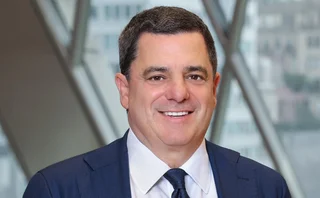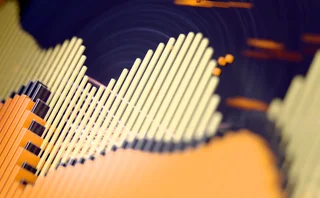
OTC trading platform of the year: trueEX
Risk Awards 2017: Innovation gives start-up Sef a foothold – and has forced incumbents to change

One way to tell the story of a trading venue is with numbers. For trueEX, the start-up swap execution facility (Sef) launched by Sunil Hirani in 2012, the numbers are mixed.
Of trueEX's roughly 80 buy-side clients, Hirani says only 20 are trading heavily. It has convinced most of the internationally active derivatives dealers to provide liquidity on the platform, but users on the platform report that four are still holding out – Bank of America, Barclays, Deutsche Bank and Morgan Stanley. Its share of the dealer-to-client electronic interest rate swaps market has also jumped fourfold in the past year – in its busiest week, racking up more than a quarter of the market's volume – but over the entire period it still has only 7.7% of the total.
Arguably, the most important number in the trueEX story, though, is the number one – Hirani's platform is the last surviving member of a crop of start-up Sefs that hoped to ride to prosperity on the back of the Dodd-Frank Act's electronic trading mandate for cleared swaps. And that's why numbers don't do the story justice.
"Out of all the dealer-to-client Sefs launched as a consequence of Dodd-Frank, of all those independent non-incumbents, the only one that survives is trueEX – I think that tells you a lot," says a rates trader at a UK bank. "The reason it survived is because trueEX has been more innovative than the two incumbent end-user Sefs, Bloomberg and Tradeweb."
It's because of trueEX that end-user compressions are all automated now
A rates trader at a UK bank
The best example of that innovation is trade compressions and the technology behind it. Previously, eliminating unnecessary trades from a bilateral portfolio had been a time-consuming, manual task – but in a world of pre-trade clearing credit check, fees and leverage ratios, it also became a vital way to manage costs. Hirani's platform was the first to spend the time and money automating it, but the two incumbents in the dealer-to-client space have since followed suit.
"Since then, both Bloomberg and Tradeweb have tried to replicate their model and added compression tools, but it's because of trueEX that end-user compressions are all automated now," the trader says.
This is an observation made time and again by the platform's users on both the buy and sell side – that trueEX has pioneered new trading tools and services that some market participants have requested for years, forcing the two incumbents to reluctantly play catch-up.
This year's innovations include expanding the list of traded products and currencies, and allowing end-users to call for a two-way price when initiating a trade via the request-for-quote (RFQ) protocol – still the dominant mode of trading for buy-side firms. Trading on a two-way price is a way of masking a firm's intent and ensuring it can't be front-run.
"TrueEX was the first platform to build that for swaps, allowing us to show a two-way RFQ to the market so when we execute, the parties who did not win the trade don't know whether we traded the bid or the offer. That was a feature that was important to us; trueEX was first to offer it and now Tradeweb is offering it too. You have to give trueEX credit for shaking up the market," says one quant hedge fund manager.
Shaking things up
Shaking up the market was the only way to succeed, according to Hirani. An OTC trading veteran, he first pioneered electronic trading of credit default swaps at Creditex in 2004, before selling the business to Ice for $625 million in 2008. His strategy with trueEX had to be different.
"We worked with both the buy side and the dealers to find what their needs were and their pain points. That was our strategy and it was one developed by necessity. Both Bloomberg and Tradeweb have been around for more than 20 years, which makes it much harder for us to compete with them head-to-head. We had to find products and services, currencies and jurisdictions or order types that the incumbents don't offer," he says.
"This space is littered with numerous examples of trading platforms that were not successful, and sometimes I think the fact we get any volumes and that we've had people onboard with us is a little bit of a miracle. People always ask me why do clients give trueEX a shot? The reason they onboard is because we will build products and services for them that the two incumbent Sefs will not touch. That's what makes us unique – our drive to find unique products and services to outflank the existing competition," he adds.
Small niches
It is a strategy that involves chiselling out small niches for the platform, which collectively provide a decent foothold. In late November, trueEX executed its first Chilean peso interest rate swap, with its first Czech koruna interest rate swap executed in the first week of December. These latest additions bring the number of traded currencies on the platform to 20.
In terms of products, beyond the plain vanilla, spot-starting fixed-to-floating Libor rate swap that represents the lion's share of the volume transacted on the two incumbent Sefs, trueEX has worked to develop a broader product suite, including forward rate agreements and overnight indexed swaps, with swaptions trading to be introduced in the first quarter of 2017.
Hirani admits these small steps do not signal a revolution in buy-side derivatives trading – not yet, anyway. The hope is that they may eventually bring about the larger strategic goal of creating a single platform through which clients have access to the entire trading universe, not only within the interest rate swap complex, but across all derivatives asset classes and ultimately into futures and cash markets. The addition of each new product or currency is another step towards that goal.

On the bank side, even if only one desk is willing to work with us, we'll take it
Sunil Hirani, trueEX
"Clients were asking to trade rate swaps in yen, Singapore dollar and Mexican peso, and we've added those currencies to the platform. Each additional currency will obviously not be as significant as offering US dollar rate swaps, but it tells the buy side that if you come to trueEX you can have access to the world," Hirani says.
"On the bank side, even if only one desk is willing to work with us, we'll take it. If it's the Chilean peso desk, we will take that opportunity, because it is the same documents, the same straight-through processes and the same onboarding workflow for the entire bank. Once we are at a bank, for any reason whatsoever, we will use that as a beachhead to expand into other currencies, other jurisdictions and other products within the rates complex. That is the strategy," he adds.
The strategy is bearing fruit. Over time, trueEX has coaxed the majority of the internationally active derivatives dealers into making markets on the platform, and built a healthy end-user base.
Volumes growing
This growth – though still modest – is beginning to show through in weekly Sef data compiled by Clarus Financial Technology. At the start of 2016, trueEX's traded interest rate swap volumes were extremely thin: during the week of January 25, for example, $212 billion in notional was transacted across the three dealer-to-client Sefs, but just $3 billion of that notional was executed at trueEX – 1.4% of the total.
By the middle of the year, trueEX's share of overall executed volume was beginning to climb, peaking during the week of October 24, when it executed $94 billion of the $355 billion transacted in the dealer-to-client market during that five-day period – a 26% market share.
These spikes in volume remain sporadic, however. For the 12 months to November 2016, trueEX accounted for 7.7% of total dealer-to-client interest rate swaps volume. Small as that share may be, it represents a quadrupling of volumes over the course of a single year.
Critics of the platform argue these volumes do not represent ‘true' executed risk – in which users come to the platform to put on a new derivatives trade – but rather volumes transacted through trueEX's post-trade compression (PTC) service. The latter should not be rolled up with the former, the argument goes.
It is not a universal view: "When you are executing a PTC package, you are executing offsets for all the underlying trades and then you are putting on new trades – how is that any different than a regular transaction? A risk replacement trade that is replacing 10 existing line items with a new trade is still one new trade – that is still new risk and it should rightly be counted as volume," says a sell-side user of the platform.
Compression strategy
Hirani offers a different defence: the platform had to provide clients with something unique to go up against a duopoly. Compression was the means to gain that traction.
"Those claims about compression are something we hear all the time. We respond with the question: how does it matter? Compression was a pain point for the buy side and PTC allowed us to get into that market. This was our entry strategy – no-one has been able to break into this market against Tradeweb and Bloomberg, so even if compression was our way in, how does that matter? And the reality is that those clients who started on trueEX with compression are now giving us a shot on risk trades," says Hirani.
"Look, it is impossible to break into these markets. After having worked on this project for a number of years, I've come to the conclusion that this is not a solvable problem. Any new entrant is going to encounter enormous – if not insurmountable – hurdles. It's been very difficult, but there is no precedent for anyone entering these markets, so I think our traded volumes and the traction we've achieved have to be placed in that context," he adds.
Only users who have a paid subscription or are part of a corporate subscription are able to print or copy content.
To access these options, along with all other subscription benefits, please contact info@risk.net or view our subscription options here: http://subscriptions.risk.net/subscribe
You are currently unable to print this content. Please contact info@risk.net to find out more.
You are currently unable to copy this content. Please contact info@risk.net to find out more.
Copyright Infopro Digital Limited. All rights reserved.
As outlined in our terms and conditions, https://www.infopro-digital.com/terms-and-conditions/subscriptions/ (point 2.4), printing is limited to a single copy.
If you would like to purchase additional rights please email info@risk.net
Copyright Infopro Digital Limited. All rights reserved.
You may share this content using our article tools. As outlined in our terms and conditions, https://www.infopro-digital.com/terms-and-conditions/subscriptions/ (clause 2.4), an Authorised User may only make one copy of the materials for their own personal use. You must also comply with the restrictions in clause 2.5.
If you would like to purchase additional rights please email info@risk.net
More on Awards
Collateral management and optimisation product of the year: CloudMargin
Delivering the modern blueprint for enterprise collateral resilience
Flow market-maker of the year: Citadel Securities
Risk Awards 2026: No financing; no long-dated swaps? “No distractions,” says Esposito
Pricing and analytics: fixed income – Quantifi
Quantifi delivers high-performance, transparent and adaptable pricing and risk analytics for fixed income and credit markets
Derivatives house of the year: Citi
Risk Awards 2026: Rev up, RWAs down, as US bank gets back on track (with added XiNG and XiP)
Technology vendor of the year: SS&C Algorithmics
Risk Awards 2026: From cloud, to chips, to maths tricks – vendor getting more out of existing tech
SS&C Algorithmics: winner’s interview with Curt Burmeister
SS&C Algorithmics wins three categories in this year’s Markets Technology Awards in addition to Technology vendor of the year at the Risk Awards
Best vendor for system support and implementation: Murex
Murex wins Best vendor for system support and implementation at the Markets Technology Awards 2026
Pricing and analytics: cross-asset and structured – Murex
Murex wins Pricing and analytics: cross-asset and structured at the Markets Technology Awards 2026 thanks to its MX.3 platform







